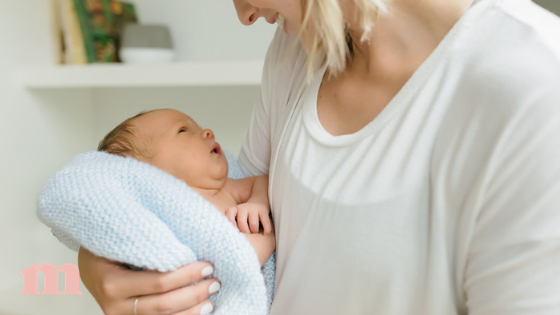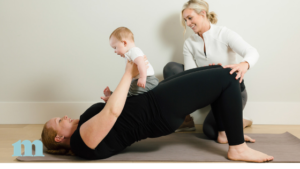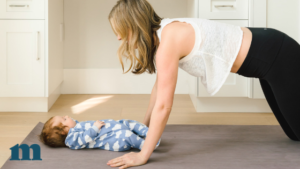The postpartum period is challenging for many mothers. Not only have you been through an incredible physical, mental and emotional challenge, but your whole world is shifting to accommodate a new baby. That is a lot to deal with all at once!
This is why balancing recovery, rest and self-care with postpartum exercise is very important. But it can be hard to manage all of the elements of recovery on top of caring for your new baby.
How do you achieve this balance?
And what exercises could help your recovery?
What you need to know about postpartum recovery, including postpartum exercise
A general timeframe for tissue healing after a trauma is about 12-16 weeks. Most postpartum women are told they can return to normal function after only 6 weeks! Talk about pressure!
The healing process can be divided into 3 stages:
- The acute stage, which includes inflammatory reaction, and lasts 4-6 days
- The sub-acute stage, which is about repair and healing, and lasts 10-17 days
- The chronic stage, which is about maturation and remodeling, and can last up to 6 months
A number of factors can influence the healing process. Make sure to consider:
- How active you were prior to pregnancy
- If you had pain or incontinence during your pregnancy
- If you had multiple births
- How long delivery lasted
- Any injuries you got during delivery
- Whether the birth was vaginal or by C-section
- If any instruments were used vaginally
Many people consider the postpartum period to be 6 weeks because that’s when women usually get clearance from their medical care provider to return to normal activities. Current guidelines suggest that it is safe to return to physical activity, work and sex after 6 weeks.
That is not the case for everyone, each person’s healing process and progress is different once all of these factors are accounted for.
Make sure you are listening to your body and respecting its needs.
Managing your postpartum recovery and exercise
It can be hard to find the time, energy or motivation to care for yourself when you have just had a baby. You will likely be exhausted, sore and overwhelmed. You may also feel guilty taking time away for yourself.
With that in mind, try to have a support network set up ahead of time. Talk to other mothers in your life about what kind of support they found helpful or wish they had had. If you have had children already, make your own list about what you found helpful and what you wish you had.
Then make a list of who you could ask for support and help. Think about who is willing to babysit and who you feel most comfortable talking to if you’re struggling. Have the list somewhere close by so if you are feeling down or overwhelmed, you’ll have a reminder to reach out for help in plain view.
Remember that difficulty adjusting to life as a new mother, social isolation and mental health issues are all very common amongst new moms, so be accepting of your journey, know that you’re not alone, and be patient and kind with yourself.
If your mental health crosses into the zone where you are scared you will hurt yourself or your baby, please seek help as soon as possible. There is support out there waiting for you. And remember that you are not alone.
Tips for postpartum exercise
When you are ready for postpartum exercise, here are some ideas to get you started at home:
-
Focus on recovering after giving birth.
To say giving birth is hard is an understatement. Take care of yourself and give your body the time and rest it needs to heal.
-
Rest whenever you can.
Rest is challenging to come by, especially after your first child. Don’t worry about sleeping at night or being awake during the day. Keep the same schedule as your baby and rest when the chance comes up. Trust me, you will need the sleep and the downtime!
-
Engage in gentle movement and re-establish good breathing patterns.
Postpartum exercise starts small. Breathing is the most important first step. Gentle movement may feel tough at the beginning, so take things slow and take breaks. You also don’t have to move every part of you. If all you can manage is your arms, move them. Every step of the way, do what you can and trust that the rest will come.
-
Use the core-pelvic floor connection breath.
Connection breath will help your core and pelvic floor function as a whole again. If you have experienced diastasis recti, connection breath can help you restore functional use of these muscles. Connection breath is also a great resource to go back to when you are feeling emotionally ungrounded or mentally scattered. Whenever you need, focus on connection breath and reconnect with yourself.
-
You can also start basic stretching and mobility.
The next step is stretching and basic mobility. You want to get all the tightness out of your muscles and get yourself more limber. Stretch slowly and don’t do anything that hurts.
-
When you are ready, start taking 10-minute walks.
Walking is going to be key to your postpartum experience. Don’t feel like you have to do a long walk at once. Instead, break your walks down into chunks – just 10 minutes at a time is a great start. Several short walks in a day is better than one long one. If you have any feelings or heaviness or pain, stop and consult with a medical professional right away!
If you need more help establishing your postpartum exercise regime, I can help! I’ll set up a full recovery program with you, helping you navigate any challenges that arise.



